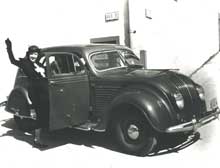Which Way Does the Airflow?
Not to put too fine a point on it, but the air flows differently than the eye expects. That was the premise of Chrysler Corporation's Airflow models, introduced for Chrysler and DeSoto in 1934. Scientifically designed to be slippery, and engineered with a truss bridge frame to be sturdy , they were technological marvels.
Unfortunately, they were sales flops, as the eye saw them as blunt instruments. DeSoto sales fell by nearly half compared to the attractive 1933 models. Chrysler did better, but only because they had retained a "conventional" line of six-cylinder cars, that outsold the Airflows two to one. DeSoto had to suffer Airflow alone. Product planners finally put a fine point on it in 1935, peaked grilles for both Chrysler and DeSoto, and there were DeSoto Airstreams as well as Chryslers.
Spares rode outside or in, depending on model, but only with Chrysler's touring trunk was there any useful luggage space. Engines sat right under the hood, requiring low-profile hoses, and access produced a huge yawn. Interiors were spacious and comfortable. Ingenious were the two-way vent wings that could be opened or lowered.
In 1936, Chrysler's Airflow and Airstream shared a grille theme, but DeSoto's Airstream took on a flair of its own while the Airflow retained its funky outlook. For 1937, DeSoto had only a conventional car, while Chrysler kept an abbreviated Airflow line that mimicked its other cars. And then the Airflow was gone. Chrysler had learned the hard way that change can be risky. But whereas the Airflow had been a sales disaster, Lincoln's technically-similar Zephyr had improved sales sixfold. One wonders why. Maybe that was the point.

